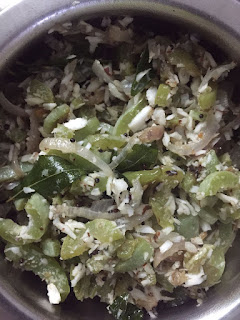Snake gourd-Health facts-Snake gourd porial
Snake gourd - Health facts
snake gourd Intro
Snake gourd(Luffa cylindrical) is a tropical fruit native to Asia. It grows in warm climates and is cultivated throughout Southeast Asia, India, China, Indonesia, Malaysia, Thailand, Vietnam, Philippines, Sri Lanka, Bangladesh, Pakistan, Nepal, Myanmar, Cambodia, Laos, and Taiwan. In Its natural habitat, the snake gourd grows in swamps and marshes. It is often referred to as the "cabbage looper due to its resemblance to the cabbage butterfly larva.
Snake gourd recipe:
Ingredients
Snake gourd - 250gm
Mustard-1 teaspoon
Urad dal - 1 teaspoon
Onion -2
Green chili - 2 no
grated coconut - 2 spoon
curry leaves some
salt as required
Method:
1. First, Wash the snake gourd thoroughly and slice it into small pieces, and keep them aside.
2. Keep a pan on the stove and pour some water for boiling the snake gourd put the sliced snake gourd into the water add salt as required, then close it with a lid. wait until it boiling well.
3. Turn off the stove when the water dries up.
4. Then keep a pan on the stove and pour one spoon of oil, add mustard, and urad dal.
5. When it is crackled then add onion, green chili, and curry leaves. stir it until the onion comes to glass consistency.
6. Then add boiled snake gourd and stir it well.
7. Finally add grated coconut. stir once.
8. Now the snake gourd poriyal is ready to serve.
Snake Gourd- How Always Fresh
1. Snake Gourd is a type of cucurbit that grows in tropical regions around the world. They have been cultivated for thousands of years. In ancient times they were grown primarily for their edible fruits. Today snake gourds are still eaten fresh, dried, pickled, and even fermented.
2. Snake Gourds have many different names depending on where they are grown. In India, they are called Snake gourds, In china, they are called snake melons, and in Africa, they are known as African pumpkins.
3. Snake gourds are not actually pumpkins at all; they belong to the Cucurbitaceae family. There are over 100 species of snake gourds, and they vary greatly in size, shape, color, and taste. Most snake gourds are about 2 feet long and weigh between 5 to 15 pounds.
4. The skin of a snake gourd is thick and tough, making them great for storing water. They are often sold in bunches of three or four.
5. Snake gourds have high sugar content, and they make excellent desserts. They are best enjoyed cooked and baked.
6. Snake gourds can be stored for months if kept cool and dry. They do not need refrigeration, but they should be wrapped well to keep out moisture.
7. Snake gourds do not require any special care once harvested. they can be left outside until frosted, then brought inside.
Health Benefits of Snake gourds
1. Snake gourds produce a lot of seeds, and these seeds are sometimes referred to as squash blossoms. These seeds are rich in fiber and protein.
2. Snake gourds may help to prevent cancer. Studies show that people who eat foods containing lycopene have lower rates of prostate cancer than those who don't. Lycopene is found in tomatoes, watermelon, guava, and types of peppers.
3. Snake gourds contain vitamins A, B, C, D, E, K, and folic acid. They also contain iron, copper, manganese, and, zinc.
4. Snake Gourds also contain antioxidants, including beta-carotene and lutein. These antioxidants protect cells from damage caused by free radicals. Free radicals cause aging and disease.
5. Snake gourds provide a variety of vitamins and minerals. They are low in calories and fat they contain no cholesterol.
6. Snake gourds make a delicious addition to salads. They can be sliced, diced, and added to soups. They can be stuffed with cheese, meat, vegetables, and herbs.










.jpeg)





Comments
Post a Comment
Thanks for commenting.